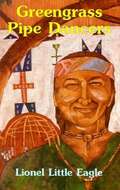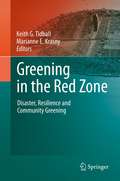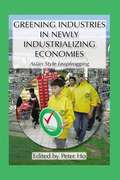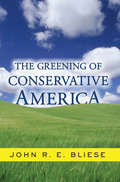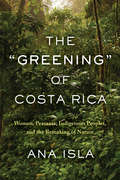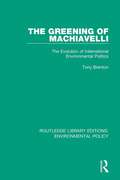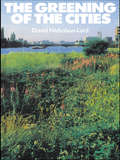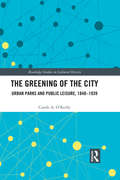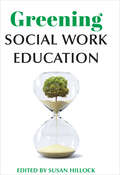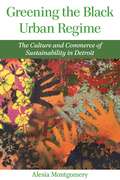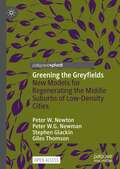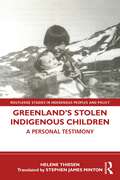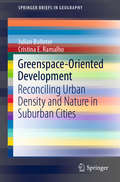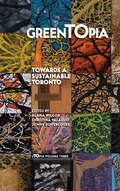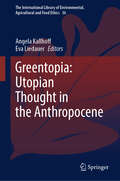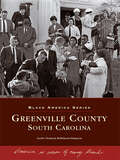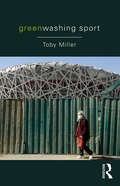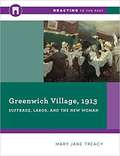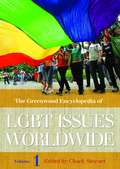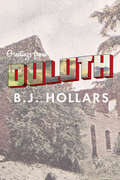- Table View
- List View
Greengrass Pipe Dancers: Crazy Horse's Pipe Bag and a Search for Healing
by Lionel Little EagleThe saga of Crazy Horse's pipe bag, given to Dr. Henry Alexander Brown by the Lakotas, is recounted through amazing stories of its often uncanny power and the rich legacy behind it.
Greening in the Red Zone: Disaster, Resilience and Community Greening
by Keith G. Tidball Marianne E. KrasnyCreation and access to green spaces promotes individual human health, especially in therapeutic contexts among those suffering traumatic events. But what of the role of access to green space and the act of creating and caring for such places in promoting social health and well-being? Greening in the Red Zone asserts that creation and access to green spaces confers resilience and recovery in systems disrupted by violent conflict or disaster. This edited volume provides evidence for this assertion through cases and examples. The contributors to this volume use a variety of research and policy frameworks to explore how creation and access to green spaces in extreme situations might contribute to resistance, recovery, and resilience of social-ecological systems.
Greening Industries
by HoFirst published in 2006. Routledge is an imprint of Taylor & Francis, an informa company.
The Greening of America
by Charles A. ReichThere is a revolution coming. It will not be like revolutions of the past. It will originate with the individual and the with culture, and it will change the political structure only as its final act. It will not require violence to succeed, and it cannot be successfully resisted by violence. This is the revolution of the new generation.
The Greening Of Conservative America
by John BlieseIs ?conservative environmentalism? an oxymoron? Is more environmental regulation good for business? The Greening of Conservative America contends that the adherents to any well-considered conservative political philosophy should, on first principles, support pro-conservation, pro-environment policies. Furthermore, and pragmatically, Bliese demonstrates with repeated examples how environmental protection policies actually benefit business by stimulating greater efficiency and innovation and by spurring the creation of green products and services for new markets around the globe. These ideas are applied in chapters on specific environmental issues, including pollution, global warming, biodiversity, public-land management, and sustainability. The book concludes with criticisms of ?free-market environmentalism? and calls conservatives back to their root principles on matters of the environment. Concerned citizens of any political persuasion will find much in this book to inform their views on public debates over environmental issues and policies.
The "Greening" of Costa Rica: Women, Peasants, Indigenous Peoples, and the Remaking of Nature
by Ana IslaSince the 1992 Earth Summit in Rio de Janeiro, the concept of sustainable development has become the basis for a vast number of "green industries" from eco-tourism to carbon sequestration. <P><P>In The "Greening" of Costa Rica, Ana Isla exposes the results of the economist's rejection of physical limits to growth, the biologist's fetish with such limits, and the indebtedness of peripheral countries. <P><P>Isla's case study is the 250,000 hectare Arenal-Tilaran Conservation Area, created in the late 1990s as the result of Canada-Costa Rica debt-for-nature swaps. <P><P> Rather than reducing poverty and creating equality, development in and around the conservation area has dispossessed and disenfranchised subsistence farmers, expropriating their land, water, knowledge, and labour. <P><P>Drawing on a decade of fieldwork in these communities, Isla exposes the duplicity of a neoliberal model in which the environment is converted into commercial assets such as carbon credits, intellectual property, cash crops, open-pit mining, and eco-tourism, few of whose benefits flow to the local population.
The Greening of Machiavelli: The Evolution of International Environmental Politics (Routledge Library Editions: Environmental Policy #4)
by Tony BrentonFirst published in 1994. Environmental issues present a daunting challenge to the international system. The destruction of the tropical rainforest, the Chernobyl explosion and the ozone layer ‘hole’ all underline the transnational nature of environmental threats and the need for states to act together in order to tackle them. How have such environmental issues entered political agendas in different parts of the world and how has that affected national positions? Can governments ever reconcile their own national interests with the international cooperation needed to deal with transboundary issues such as climate change? This book traces the history of international environmental negotiations and regulations and looks at the domestic policies upon which cooperation in the international community depends. It covers some major milestones in recent history, from the Torrey Canyon accident through to the Rio ‘Earth Summit’ and the emergence of the European Community as a major international environmental actor. It also looks at cross-cutting issues such as the role of non-governmental organizations, the environmental impacts of world agriculture and trading arrangements, industry’s attitudes, and the relationship between democracy and environmental protection. It concludes by examining how the international system has adapted, and may adapt further, to deal effectively with environmental problems, and reflects on the implications of this for the future.
The Greening of the Cities
by David Nicholson-LordFirst Published in 2004. Routledge is an imprint of Taylor & Francis, an informa company.
The Greening of the City: Urban Parks and Public Leisure, 1840-1939 (Routledge Studies in Cultural History #73)
by Carole A. O'ReillyUrban parks are a much-loved feature of the city environment. However, our knowledge of the true scale of their impact remains uneven. Much work has been done on their origins and design features, but this book aims to extend this beyond the nineteenth century, examining the fuller flowering of these valuable spaces in the early decades of the twentieth century. Encompassing themes such as social and political usage, parks as employers and the dangers posed by such freely accessible spaces, the book examines a range of parks in cities such as Manchester, Salford, Liverpool, Leeds, Preston, Hull and Cardiff and challenges the prevailing myths about their meaning for their users. This study's timeframe spans almost 100 years of unprecedented social, cultural, political and economic changes and allows for the consideration of the expansion and commercialisation of leisure opportunities for the public. Urban parks played a significant role in this — the book places parks firmly in the context of the evolving city and examines the importance of green space to the urban citizen during this most fascinating of historical periods.
Greening Social Work Education
by Susan HillockDespite urgent calls for global action, sustainable social work practice, and a solid “green” theoretical knowledge base, North American social work and helping professions have been slow to learn from community activists, acknowledge the international climate emergency, and act collectively to achieve climate justice. Greening Social Work Education examines how social work educators can best incorporate sustainability content into social work curricula, integrate green teaching methods, and mobilize students and colleagues towards climate action, justice, and leadership. Drawing on Canadian content, this collection highlights Indigenous, eco-feminist, collective-action, and multi-interdisciplinary approaches to social work. The book provides a rationale for why the topic of greening is important for social work and the helping professions; discussion of current debates, tensions, and issues; useful ideas related to innovative interdisciplinary theoretical approaches, analyses, and constructs; and practical recommendations for teaching green social work education. In doing so, Greening Social Work Education strives to help social workers and educators gain the confidence and tools they need to transform their teaching and curricula.
Greening the Black Urban Regime: The Culture and Commerce of Sustainability in Detroit (Great Lakes Books Series)
by Alesia MontgomeryAlesia Montgomery’s Greening the Black Urban Regime: The Culture and Commerce of Sustainability in Detroit tells the story of the struggle to shape green redevelopment in Detroit. Cultural workers, envisioning a green city crafted by direct democracy, had begun to draw idealistic young newcomers to Detroit’s street art and gardens. Then a billionaire developer and private foundations hired international consultants to redesign downtown and to devise a city plan. Using the justice-speak of cultural workers, these consultants did innovative outreach, but they did not enable democratic deliberation. The Detroit Future City plan won awards, and the new green venues in the gentrified downtown have gotten good press. However, low-income black Detroiters have little ability to shape "greening" as uneven development unfolds and poverty persists. Based on years of fieldwork, Montgomery takes us into the city council chambers, nonprofit offices, gardens, churches, cafés, street parties, and public protests where the future of Detroit was imagined, debated, and dictated. She begins by using statistical data and oral histories to trace the impacts of capital flight, and then she draws on interviews and observations to show how these impacts influence city planning. Hostility between blacks and whites shape the main narrative, yet indigenous, Asian, Arab, and Latinx peoples in Detroit add to the conflict. Montgomery compares Detroit to other historical black urban regimes (HBURs)—U.S. cities that elected their first black mayors soon after the 1960s civil rights movement. Critiques of ecological urbanism in HBURs typically focus on gentrification. In contrast, Montgomery identifies the danger as minoritization: the imposition of "beneficent" governance across gentrified and non-gentrified neighborhoods that treats the black urban poor as children of nature who lack the (mental, material) capacities to decide their future. Scholars and students in the social sciences, as well as general readers with social and environmental justice concerns, will find great value in this research.
Greening the Greyfields: New Models for Regenerating the Middle Suburbs of Low-Density Cities
by Peter W. Newton Peter W.G. Newman Stephen Glackin Giles ThomsonThis open access book outlines new concepts, development models, governance and implementation processes capable of addressing the challenges of transformative urban regeneration of cities at precinct scale.
Greenland's Economy and Labour Markets (Routledge Research in Polar Regions)
by Laust HøgedahlThis book explores structural changes in Greenland’s economy and labour markets due to the transformative effects of climatic changes and growing international attention. It offers multidisciplinary perspectives from economists, sociologists, and political scientists to demonstrate how the Greenlandic economy works. Due to an increasing focus on the Arctic area and Greenland in particular, the book seeks to understand the functioning and dynamics of Greenland’s labour economy, as well as the challenges that arise from the melting ice and internationalisation. It fills a substantive gap in the existing literature by compiling research on these critical subjects and exploring current and future opportunities for labourers. Today, Greenland is reliant on large financial subsidies from Denmark to provide for a large share of its national budget. This fuels Greenland’s political ambition to gain greater independence from Denmark, which requires more private sector growth to develop a sustainable economy. This book thus contains an exhaustive introduction to important business development themes such as macroeconomics, markets, labour supply, labour market policies, and institutions and considers Greenland’s colonial past, great Inuit heritage, and unique geography and nature to re-shape its economy and labour markets. Informed by a lucid writing style, each chapter casts light on different economic and social issues of Greenland. This is the first international book on Greenland’s economy which discusses its geopolitical importance and prospects for the Arctic region. It will be a valuable point of reference for students and academics of economics, Arctic research and political economy.
Greenland’s Stolen Indigenous Children: A Personal Testimony (Routledge Studies in Indigenous Peoples and Policy)
by Helene ThiesenIn this book, author Helene Thiesen recounts her experience of being removed from her family in Greenland as a young Inuk child, to be ‘re-educated’ in Denmark and an orphanage in Greenland. The practice of forcible assimilation of Indigenous children into colonial societies through ‘education’ has echoes in North America and Australasia, and the painful legacy of these practices remains under-acknowledged. In this poignant book, Helene recounts in detail the process of being taken from her family in 1951, aged seven, along with twenty-one other children, in the attempt to re-make them into ‘model Danish citizens’, in a social ‘experiment’ led by the Danish government and Save the Children Denmark. When the children returned to Greenland a year and a half later, they were sent to live in a Danish Red Cross orphanage, where they were forbidden to speak their native languages, and were compelled to adopt Danish language, culture and customs. With a detailed introductory analysis from Dr Stephen James Minton, who also provides the translation, Helene’s account serves as a compelling and powerful testimony of a devastating colonial experiment. Richly illustrated with forty photos to help to situate the reader, this book provides an invaluable case study for researchers and students in the fields of Indigenous Studies, Critical Pedagogy and Education, Psychology, European History, and Cultural Studies.
Greenspace-Oriented Development: Reconciling Urban Density and Nature in Suburban Cities (SpringerBriefs in Geography)
by Julian Bolleter Cristina E. RamalhoTransit-Oriented Development (TOD) planning principles have informed Australian city planning for over two decades. As such, policy makers and planners often unquestioningly apply its principles. In contrast, this book critiques TOD and argues that while orientating development towards public transport hubs makes some sense, the application of TOD principles in Australia has proven a significant challenge. As a complementary strategy, the book stakes out the potential of Greenspace-Oriented Development (GOD) in which urban density is correlated with upgraded green spaces with reasonable access to public transport. Concentrating urban densification around green spaces offers many advantages to residents including ecosystem services such as physical and mental health benefits, the mitigation of extreme heat events, biodiversity and clean air and water. Moreover, the open space and leafy green qualities of GOD will ensure it resonates with the lifestyle aspirations of suburban residents who may otherwise resist urban densification. We believe in this way, that GOD could be an urban dream that befits the challenges of this 21st century.
Greentopia: Towards a Sustainable Toronto (uTOpia)
by Jonny Dovercourt Alana WilcoxGardening the Gardiner. Hydrogen-fuelled cabs. Rooftop Power. Rainwater harvesting. A new model of taxation. The art of salvage. Drinking less coffee. Composters for dog poo in city parks. Ravine City.What would make Toronto a greener place?This third book in the uTOpia series asked imaginative Torontonians to think both big and small about how we might make our city more environmentally wise and responsible. They responded with immodest proposals and how-to tips, thoughtful considerations and flights of fancy that just might work. They wrote essays long and short, taking stock of how far weve come in the struggle to green ourselves and providing suggestions for simple actions with big effects. Their ideas sometimes playful, sometimes pie-in-the-sky offer brazen new perspectives on transportation, garbage, trees, energy, water, animals and green space and arrive at imaginative and ingenious solutions to the problems plaguing all modern cities.GreenTOpia features a resources section, including profiles of key eco-friendly groups in the GTA, a directory of green organizations, as well as a how-to guide and a fun-facts section.
Greentopia: Utopian Thought in the Anthropocene (The International Library of Environmental, Agricultural and Food Ethics #36)
by Angela Kallhoff Eva LiedauerGreentopia: Utopian Thought in the Anthropocene provides new ways of imagining the future interface between society and non-human nature and brings into focus the possibility of a peaceful coexistence. “Greentopia” is a mode of thought that takes us beyond mourning environmental degradation and ecological catastrophe. The absence of already-paved paths in the area gives space for a variety of experiments in thinking. The book interprets its subject, “Greentopia”, as a method of re-imagination, yet also as a very concrete practice. It brings together researchers from different areas to investigate environmental utopia from their respective angles. The present volume is of highest interest for environmental ethicists, but also of interest for anyone involved in current discourses on utopianism, life in the Anthropocene, environmental crises, the future of agriculture and green cities.
Greenville County, South Carolina (Black America Series)
by Leola Clement Robinson-SimpsonCradled at the foothills of the beautiful Blue Ridge Mountains and once known as the "Textile Center of the South," Greenville has evolved into a prosperous hub for corporate development and global commerce. Greenville County's African American community, proud and resourceful, has strong roots dating back to 1770, when blacks helped to carve the county out of an upstate wilderness. The experiences of the black community and its long relationship with whites up to the civil rights movement helped to create the climate for the kaleidoscope of races and cultures in Greenville today.
Greenwashing Culture
by Toby MillerGreenwashing Culture examines the complicity of culture with our environmental crisis. Through its own carbon footprint, the promotion of image-friendly environmental credentials for celebrities, and the mutually beneficial engagement with big industry polluters, Toby Miller argues that culture has become an enabler of environmental criminals to win over local, national, and international communities. Topics include: the environmental liabilities involved in digital and print technologies used by cultural institutions and their consumers; Hollywood's 'green celebrities' and the immense ecological impact of their jet-setting lifestyles and filmmaking itself; high profile sponsorship deals between museums and oil and gas companies, such as BP's sponsorship of Tate Britain; radical environmental reform, via citizenship and public policy, illustrated by the actions of Greenpeace against Shell's sponsorship of Lego. This is a thought-provoking introduction to the harmful impact of greenwashing. It is essential reading for students of cultural studies and environmental studies, and those with an interest in environmental activism.
Greenwashing Sport
by Toby MillerProfessional sports promote their green credentials and yet remain complicit in our global environmental crisis Sports are responsible for significant carbon footprints through stadium construction and energy use, player and spectator travel, and media coverage. The impact of sports on climate change is further compounded by sponsorship deals with the gas and petroleum industries—imbuing those extractive corporations with a positive image by embedding them within the everyday pleasure of sport. Toby Miller argues that such activities amount to "greenwashing". Scrutinizing motor racing, association football, and the Olympics, Miller weighs up their environmental policies, their rhetoric of conservation and sustainability, and their green credentials. The book concludes with the role of green citizenship and organic fan activism in promoting pro-environmental sports. This is a must-read for students and researchers in media, communications, sociology, cultural studies, and environmental studies.
Greenwich Village 1913: Suffrage, Labor, And The New Woman
by Mary Jane TreacyIn this Reacting to the Past game, the classroom is transformed into Greenwich Village in 1913, where rebellious “free spirits” gather. Exposed to ideas like woman suffrage, socialism, birth control, and anarchism, students experiment with forms of political participation and bohemian self-discovery. Reacting to the Past is an award-winning series of immersive role-playing games that actively engage students in their own learning. Students assume the roles of historical characters and practice critical thinking, primary source analysis, and argument, both written and spoken.
The Greenwood Encyclopedia of LGBT Issues Worldwide, Volume 1: The Americas and the Caribbean
by Chuck K. StewartThis set has an ambitious scope with the goal of offering the most up-to-date international overview of key issues in the lives of lesbian, gay, bisexual, and transgender individuals. HIV/AIDS has been a major media focus, but this set fosters a broader understanding of the status of LGBT individuals in their society. More than 70 countries are represented. The clear, accessible prose is appropriate for high school student research on up. The material is especially needed in a cultural climate that supports and informs about LGBT populations. The content is useful for a paper on a hot topic, health classes, discussion groups, and gay-straight alliance groups. This set has an ambitious scope with the goal of offering the most up-to-date international overview of key issues in the lives of lesbian, gay, bisexual, and transgender individuals. HIV/AIDS has been a major media focus, but this set fosters a broader understanding of the status of LGBT individuals in their society. More than 70 countries are represented. The clear, accessible prose is appropriate for high school student research on up. The material is especially needed in a cultural climate that supports and informs about LGBT populations. The content is useful for a paper on a hot topic, health classes, discussion groups, and gay-straight alliance groups.
The Greenwood Encyclopedia of LGBT Issues Worldwide, Volume 2: Europe
by Chuck K. StewartThis set has an ambitious scope with the goal of offering the most up-to-date international overview of key issues in the lives of lesbian, gay, bisexual, and transgender individuals. HIV/AIDS has been a major media focus, but this set fosters a broader understanding of the status of LGBT individuals in their society. More than 70 countries are represented. The clear, accessible prose is appropriate for high school student research on up. The material is especially needed in a cultural climate that supports and informs about LGBT populations. The content is useful for a paper on a hot topic, health classes, discussion groups, and gay-straight alliance groups.This set has an ambitious scope with the goal of offering the most up-to-date international overview of key issues in the lives of lesbian, gay, bisexual, and transgender individuals. HIV/AIDS has been a major media focus, but this set fosters a broader understanding of the status of LGBT individuals in their society. More than 70 countries are represented. The clear, accessible prose is appropriate for high school student research on up. The material is especially needed in a cultural climate that supports and informs about LGBT populations. The content is useful for a paper on a hot topic, health classes, discussion groups, and gay-straight alliance groups.
The Greenwood Encyclopedia of LGBT Issues Worldwide, Volume 3: Africa and the Middle East
by Chuck K. StewartThis set has an ambitious scope with the goal of offering the most up-to-date international overview of key issues in the lives of lesbian, gay, bisexual, and transgender individuals. HIV/AIDS has been a major media focus, but this set fosters a broader understanding of the status of LGBT individuals in their society. More than 70 countries are represented. The clear, accessible prose is appropriate for high school student research on up. The material is especially needed in a cultural climate that supports and informs about LGBT populations. The content is useful for a paper on a hot topic, health classes, discussion groups, and gay-straight alliance groups.This set has an ambitious scope with the goal of offering the most up-to-date international overview of key issues in the lives of lesbian, gay, bisexual, and transgender individuals. HIV/AIDS has been a major media focus, but this set fosters a broader understanding of the status of LGBT individuals in their society. More than 70 countries are represented. The clear, accessible prose is appropriate for high school student research on up. The material is especially needed in a cultural climate that supports and informs about LGBT populations. The content is useful for a paper on a hot topic, health classes, discussion groups, and gay-straight alliance groups.
Greetings from Duluth: Essays on Destruction
by B. J. HollarsJoin B.J. Hollars as he takes readers on a whirlwind tour of destruction: from Fort Wayne's almost-obliteration at the hands of Adolf Hitler, to Tuscaloosa's 2011 tornado, and finally, to a triple lynching that occurred in Duluth in the summer of 1920. Spanning nearly a continent and a century, Hollars re-reports the details of these destructions, uncovering new facts and new perspectives in the swirl of what little remains. Relying on equal parts lyricism, experimental forms, and personal experience, Hollars' "Greetings From Duluth" explores our complicated relationship with the places we call home.
